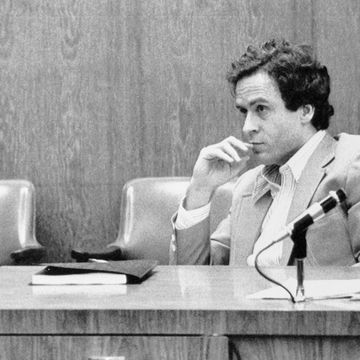1941–1991
Latest News: Richard Speck Appears in Monster: The Ed Gein Story
The Netflix true crime series Monster: The Ed Gein Story suggests killer Richard Speck found inspiration in Ed Gein’s murders—and even wrote to the killer after his arrest. While this more than likely isn’t true based on what we know about the pair, the series is bringing renewed attention to Speck’s life and crimes.
In Monster, Speck (played by Tobias Jelenik) corresponds with Gein (Charlie Hunnam) via letters, calling him a friend and “role model.” The real Speck was convicted of killing eight women on Chicago’s South Side in 1966 and sentenced to death, though the sentence was later commuted to 50 to 100 years in prison.
However, there is no direct evidence that Gein’s crimes influenced Speck, or that the pair ever communicated.
Instead, the eighth-episode scene appears to be a creative choice by showrunners Ryan Murphy and Ian Brennan—helping illustrate Gein’s potential effect on real criminals and enduring legacy in fictional horror media. Other infamous figures, such as Edmund Kemper and Charles Manson, appear during a short sequence in Gein’s imagination (the real Gein was diagnosed with schizophrenia and kept in psychiatric confinement until his 1984 death).
“There were many, many dark creatures in our world—Richard Speck, Ted Bundy—who were influenced and obsessed with Ed for all the wrong reasons,” Murphy told Tudum.
Who Was Richard Speck?
Richard Speck was a convicted killer who captured the nation’s attention during the summer of 1966 after murdering eight female students who lived together on Chicago’s South Side. Before then, he had been responsible for other acts of violence against his family and others, but had a knack for escaping the police. After his killing spree the night of July 13, 1966, a manhunt ensued and he was captured two days later. He spent the rest of his life in prison until he died of a heart attack in 1991 at age 49.
Quick Facts
FULL NAME: Richard Benjamin Speck
BORN: December 6, 1941
DIED: December 5, 1991
SPOUSE: Shirley Ann Malone (c. 1962-1966)
CHILD: Bobby Lynn
ASTROLOGICAL SIGN: Sagittarius
HEIGHT: 6 ft. 1 in.
Early Years and Tattoo
Richard Benjamin Speck was born on December 6, 1941, in Kirkwood, Illinois, into a large, religious family, where he was the seventh of eight children. After the death of his father when Speck was six, his mother remarried, moving the family to Dallas. The children suffered considerable abuse at the hands of their drunken stepfather, and Speck’s childhood was marked by juvenile delinquency and alcohol abuse, which soon led to petty crime.
Speck received him a jail sentence for theft and check fraud in 1963. Paroled in January 1965, he lasted only four weeks outside, before being arrested again for aggravated assault, and he was jailed for a further 16 months, of which he served 6 months. During this period he had the words “Born to Raise Hell” tattooed on his arm.
Wife and Daughter
The tattoo was a sentiment Speck’s wife Shirley Malone experienced firsthand. The couple married in November 1962 and had a daughter, Bobby Lynn, soon after. Their married bliss was short-lived.
Malone filed for divorce in January 1966. After Speck was arrested for burglary and assault, he fled to Chicago to seek shelter with his sister, Martha, a couple of months later. He spent a few days there before traveling to Monmouth, Illinois, where he stayed with some family friends from early childhood.
Chicago Murders and Other Possible Crimes
For a short time he was a carpenter, but soon he was in trouble again: 65-year-old Virgil Harris was viciously raped and robbed in her own home on April 2, 1966, and on April 13 a barmaid in his local tavern, Mary Kay Pierce, was brutally beaten to death. He managed to deflect police questioning and escape once again, but police discovered some of Harris’ personal effects in Speck’s vacant hotel room that tied him to her attack.
Speck found work on a ship, and it began to seem like bodies turned up wherever Speck went. Indiana authorities wanted to interview Speck regarding the murder of three girls who had vanished on July 2, 1966, and whose bodies were never found. Michigan authorities also wanted to question him about his whereabouts during the murder of four other females, aged between 7 and 60, as his ship had been in the vicinity at the time. Speck, however, seemed to have a knack for making a quick escape and keeping police forces guessing.
These attacks, however, paled into insignificance on July 13, 1966, when Speck arrived on the doorstep of a townhouse in South Chicago, which served as a communal home for a group of eight young student nurses from nearby South Chicago Community Hospital.
When 23-year-old Corazon Amurao opened the front door to Speck’s knock, he forced his way in at gunpoint. Speck then rounded the women up and ordered them to empty their purses, before tying them all up. He proceeded to brutalize them in horrific fashion over the following few hours. Those who had been out at the time of his arrival found themselves also subjected to brutal attacks when they returned home later that evening.
A total of eight women between the ages 19 and 24 were systematically bound, robbed, beaten, strangled, and stabbed during Speck’s frenzy. At least one victim was raped. The body count was so high he failed to notice Amurao, who had opened the door for him on his arrival, had managed to hide herself under one of the beds. When he eventually left with the stolen money, she cowered in her hiding place for hours, terrified, before finally summoning the courage to seek help. She climbed out on a window ledge and screamed for help, at which point concerned neighbors summoned the police.
Arrest and Aftermath
The police arrived to scenes of carnage, and took Amurao into custody, interviewing her and proceeding with the construction of a facial composite. Fortunately, Amurao remembered the distinctive “Born to Raise Hell” tattoo that, along with the image, enabled police to identify their suspect as Richard Speck. Subsequent nationwide enquiries also raised the other incidents in which Speck was suspected, as well as his criminal record. In the days before automated fingerprint identification, the process to identify the prints found in the townhouse as his took nearly a week.
Media coverage splashed Speck’s image all over the front pages. Speck attempted suicide on July 19, 1966. He was treated for injuries in the Cook County hospital, where, again, his tattoo gave him away, and he was arrested and taken into custody.
Trial and Imprisonment
Speck’s trial began on April 3, 1967, and his claim that he had no recollection of the eight murders committed placed Corazon Amurao in the spotlight as the star witness. Despite concerns about her ability to testify after her harrowing ordeal, she gave a faultless performance, impressing the jury with every detail of that evening, identifying Speck unequivocally.
The trial lasted just 12 days and, on April 15, 1967, the jury found Speck guilty of all eight murders, after less than an hour’s deliberation. The judge sentenced Speck to death on June 5, 1967.
In 1972, the U.S. Supreme Court abolished capital punishment and Speck’s death sentence was commuted to 50 to 100 years in prison. Speck was never officially charged with the murders of which he was suspected prior to the events that took place in the South Chicago townhouse and, officially, those cases remain unsolved.
Death and Later Depictions
The imprisoned Speck died of a heart attack on December 5, 1991, just one day shy of his 50th birthday.
In 1996, five years after Speck’s death, a TV journalist released a prison video, which showed Speck taking drugs and engaging in sex with another inmate during the 1980s while he was an inmate at Statesville Correctional Institute. In the video, Speck appears to be wearing women’s underwear and have grown breasts, a result of hormone treatments he reportedly underwent while in prison. Speck also casually admits to the killing of the nurses on tape, describing the strangulations in some detail, and bragging about the strength required to kill someone in this manner.
The video’s release caused a major scandal within the Illinois Department of Corrections, and was widely cited as justification for the reintroduction of death penalty.
Speck’s crimes have helped inspire multiple documentaries and media projects. In 2007, Corin Nemic portrayed the killer in the full-length movie Chicago Massacre: Richard Speck.
Most recently in 2025, a fictional version of Speck (played by Tobias Jelenik) appeared in the anthology series Monster: The Ed Gein Story.
Fact Check: We strive for accuracy and fairness. If you see something that doesn’t look right, contact us!
The Biography.com staff is a team of people-obsessed and news-hungry editors with decades of collective experience. We have worked as daily newspaper reporters, major national magazine editors, and as editors-in-chief of regional media publications. Among our ranks are book authors and award-winning journalists. Our staff also works with freelance writers, researchers, and other contributors to produce the smart, compelling profiles and articles you see on our site. To meet the team, visit our About Us page: https://www.biography.com/about/a43602329/about-us
Tyler Piccotti joined the Biography.com staff as an Associate News Editor and is now the News and Culture Editor. He previously worked as a reporter and copy editor for a daily newspaper recognized by the Associated Press Sports Editors. In his current role, he shares the true stories behind your favorite movies and TV shows and profiles rising musicians, actors, and athletes. When he's not working, you can find him at the nearest amusement park or movie theater and cheering on his favorite teams.














